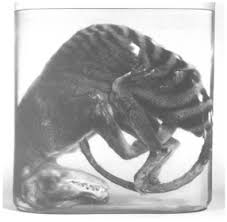Our EH Visiting Fellow, Dr Hannha Stark, will give a paper on her research on Wednesday 6th September (1pm, IASH, 2 Hope Park Square):
‘Extinction Afterlives: The Thylacine in the Era of Species Mass-Extinction’
Abstract: What ethical and political questions arise when we look at extinct animals? This paper utilises the Thylacine as a case study to work through ideas about specular commerce, memorialisation, and mourning, and advances a more-than-human approach to the commemorative landscape of Australia. Thylacines were once found throughout Australia and New Guinea, but disappeared on mainland Australia approximately 2000 years ago. In Tasmania, the Thylacine was framed as a predator of livestock and a government bounty on their head from 1880-1910 meant that the species was hunted to extinction. It took just 133 years for the thylacine to become extinct after European settlement. The ‘last’ Thylacine, known as ‘Benjamin,’ died cold, alone and neglected, on the 7th of September 1936 at Beaumaris Zoological Gardens on the Hobart Domain. The Thylacine provides a particularly apposite case-study for thinking through the construction of the human-animal relationship, bringing together multiple points of interconnection including zoos, museums, farming, laboratory science, hunting and the exploitation of animals as metaphors. Through examining the history of institutional swaps, and the economic relationships between museums, zoos, and international fairs, this project reveals the extinction economies in which the commodification and value of specimens occurs in inverse proportion to the diminishment of species diversity and the deterioration of mounts and wet specimens. There are just over 750 Thylacine specimens (taxidermy creatures, skins, skeletons, pieces of bone or preserved internal organs) held in institutions all around the world. This paper will discuss the display of Thylacine specimens at a range of Australian and European museums, and the place of the Thylacine as a global symbol of extinction.



